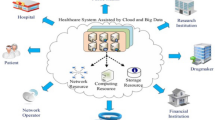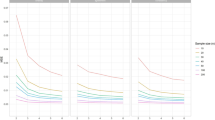Abstract
The large volumes of laboratory data currently available in clinical practice can lead to erroneous conclusions. Our current statistical interpretation of these data is univariate (one variable at a time) and often not age-and sex-corrected. Using an optimal technique of multivariate analysis, a SMAC® profile of 19 tests performed on normal subjects resulted in over a 500% improvement in defining the reference range. Using physiologic subsets of the SMAC profile for patients, improvements in interpretation of between 100% and 300% are possible. Results indicate a serious clinical problem that will require modification of laboratory reports using modern technology as an adjunct for diagnostic medicine.
Similar content being viewed by others
References
Grams, R.R., and Pastor, E.L., New concepts in the design of a clinical laboratory informations system (LIS),Am. J. Clin. Pathol. 65:662–674, 1976.
Grams, R.R., A laboratory information system (LIS) in a tertiary care teaching hospital and clinic.Examination of Case Studies and Productivity Improvement in Clinical Laboratories Center for Hospital Management Engineering, American Hospital Association, 1977, pp. 73–91.
Sisson, J.C., Shoemaker E.B., and Ross, J.C., Clinical decision analysis—the hazard of using additional data.J. Am Med. Assoc. 236: 1259–1263, 1976.
Anderson, T.W.,An Introduction to Multivariate Statistical Analysis. Wiley, New York, 1958, pp. 1–38.
Morris, D.F.,Multivariate Statistical Methods, McGraw-Hill, New York, 1967, pp. 1–415.
Grams, R.R., Lezotte D.C., and Gudat, J.C., Establishing “reference values” for the futureJ. Med. Syst. 2:355–362.
Sunderman, F.W., Current concepts of “normal values,” “reference values” and “discrimination values” in clinical chemistry.Clin. Chem. 21:1873–1877, 1975.
Schoen, I., and Books, S., Judgement based on 95% confidence limits a statistical dilemma involving multitest screening and proficiency testing of multiple specimens.Am. J. Clin. Pathol. 53:190–193, 1970.
Elseback, L.R., Crallier, L., and Keating, F.R., Health, normality, and the ghost of Gauss.J. Am. Med. Assoc. 211:69–75, 1970.
Grasbuck, R., and Saris, N.E., Establishment and use of normal values.Scand. J. Clin. Lab. Invest. 24:62, 1969.
Grams, R.R., and Lezotte, D., Determining clinical significance in repeated laboratory measurements — the “Clinical Delta Range” (to be published).
Grams, R.R., A proposal for laboratory data reporting (in review).
Author information
Authors and Affiliations
Rights and permissions
About this article
Cite this article
Grams, R.R., Lezotte, D. Unlimited volumes of laboratory data. J Med Syst 2, 343–353 (1978). https://doi.org/10.1007/BF02221900
Issue Date:
DOI: https://doi.org/10.1007/BF02221900




